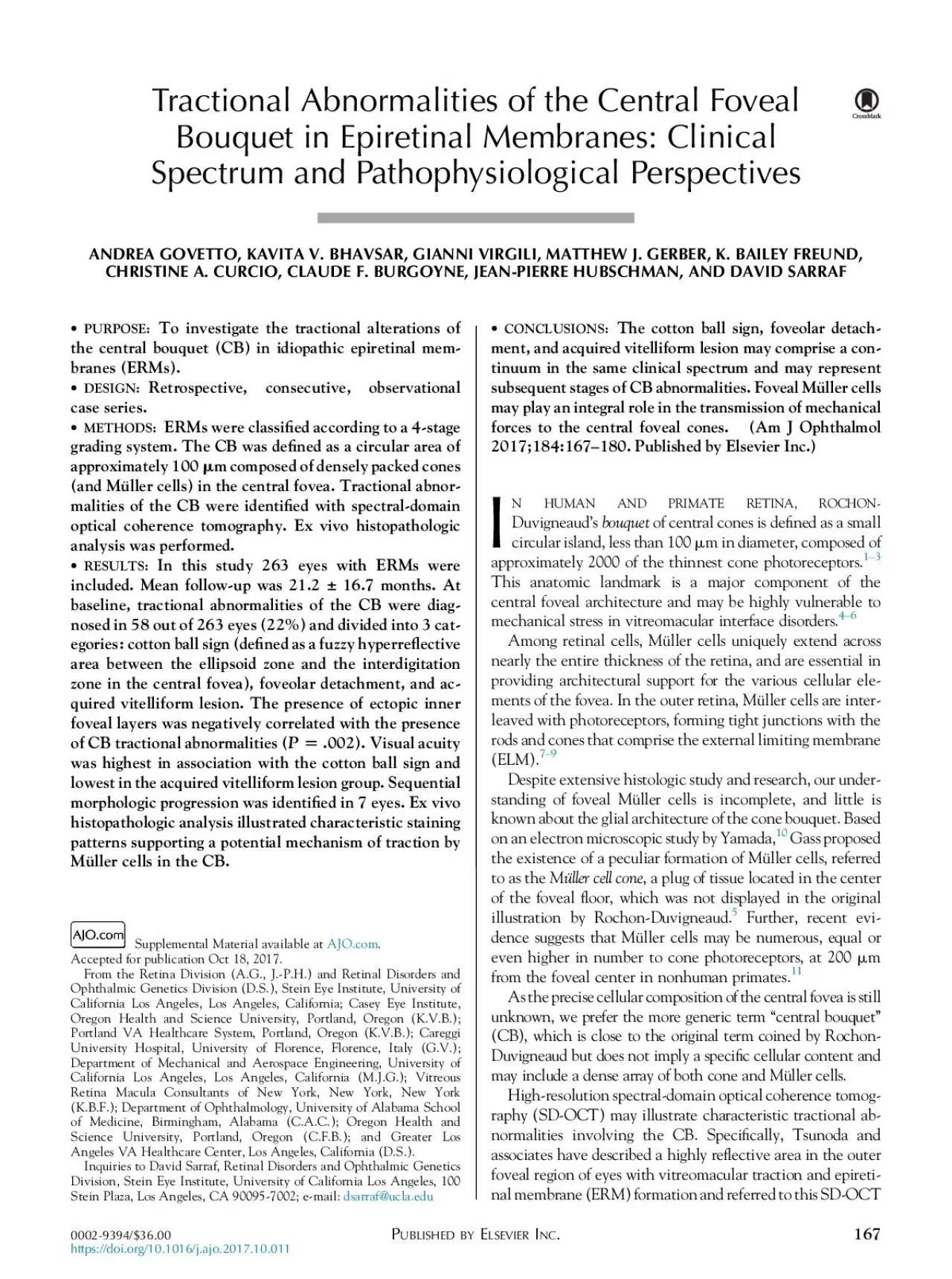

CONCLUSIONSThecottonballsignfoveolardetachmentandacquiredvitelliformlesionmaycompriseacon SupplementalMaterialavailableatAcceptedforpublicationOct182017FromtheRetinaDivisionAGJPHandRet ID: 939632
Download Pdf The PPT/PDF document "TractionalAbnormalitiesoftheCentralFovea..." is the property of its rightful owner. Permission is granted to download and print the materials on this web site for personal, non-commercial use only, and to display it on your personal computer provided you do not modify the materials and that you retain all copyright notices contained in the materials. By downloading content from our website, you accept the terms of this agreement.
TractionalAbnormalitiesoftheCentralFovealBouquetinEpiretinalMembranes:ClinicalSpectrumandPathophysiologicalPerspectivesANDREAGOVETTO,KAVITAV.BHAVSAR,GIANNIVIRGILI,MATTHEWJ.GERBER,K.BAILEYFREUND,CHRISTINEA.CURCIO,CLAUDEF.BURGOYNE,JEAN-PIERREHUBSCHMAN,ANDDAVIDSARRAFToinvestigatethetractionalalterationsofthecentralbouquet(CB)inidiopathicepiretinalmem-branes(ERMs).Retrospective,consecutive,observationalcaseseries.ERMswereclassiÞedaccordingtoa4-stagegradingsystem.TheCBwasdeÞnedasacircularareaofapproximately100mcomposedofdenselypackedcones(andMullercells)inthecentralfovea.Tractionalabnor-malitiesoftheCBwereidentiÞedwithspectral-domainopticalcoherencetomography.Exvivohistopathologicanalysiswasperformed. CONCLUSIONS:Thecottonballsign,foveolardetach-ment,andacquiredvitelliformlesionmaycompriseacon- SupplementalMaterialavailableatAcceptedforpublicationOct18,2017.FromtheRetinaDivision(A.G.,J.-P.H.)andRetinalDisordersandOphthalmicGeneticsDivision(D.S.),SteinEyeInstitute,UniversityofCaliforniaLosAngeles,LosAngeles,California;CaseyEyeInstitute,OregonHealthandScienceUniversity,Portland,Oregon(K.V.B.);PortlandVAHealthcareSystem,Portland,Oregon(K.V.B.);CareggiUniversityHospital,UniversityofFlorence,Florence,Italy(G.V.);DepartmentofMechanicalandAerospaceEngineering,UniversityofCaliforniaLosAngeles,LosAngeles,California(M.J.G.);VitreousRetinaMaculaConsultantsofNewYork,NewYork,NewYork(K.B.F.);DepartmentofOphthalmology,UniversityofAlabamaSchoolofMedicine,Birmingham,Alabama(C.A.C.);OregonHealthandScienceUniversity,Portland,Oregon(C.F.B.);andGreaterLosAngelesVAHealthcareCenter,LosAngeles,California(D.S.).InquiriestoDavidSarraf,RetinalDisordersandOphthalmicGeneticsDivision,SteinEyeInstitute,UniversityofCaliforniaLosAngeles,100SteinPlaza,LosAngeles,CA90095-7002;e-mail: 0002-9394/$36.00https://doi.org/10.1016/j.ajo.2017.10.011UBLISHEDBYLSEVIER ndingasthecottonballsignMoreover,PisonandassociatesreportedthepresenceoffoveolardetachmentinasubsetofeyeswithidiopathicERM,whileotherauthorshavenotedtheformationofacentralacquiredvitelliformlesioninpa-tientswithvitreomacularinterfacedisorder.1315WeproposethatsuchlesionsmaycompriseacontinuousclinicalspectrumandmayrepresentsubsequentstagesinthedevelopmentoftractionalCBabnormalities.ThemorphologyandlocationoftheseabnormalitiessuggestanintegralroleoffovealMu¨llercellsinthisprocess.Me-chanicalstressmaybeexertedonthestructuralelementsofthefoveaowingtotheintimateinterconnectednetworkoffovealMu¨llercellsthatinterleavewiththeCB.ThepurposeofthisstudyistoevaluatethishypothesisbydescribingandcharacterizingtheSD-OCT ndingsofcen-tralfovealhyperre ectivity(ie,thecottonballsign),foveo-lardetachment,andacquiredvitelliformlesioninalargeconsecutivecohortofpatientswithidiopathicepiretinalmembraneformation.STUDYDESIGN:ThiswasaninstitutionalstudycarriedoutattheSteinEyeInstituteinadherencetothetenetsoftheDeclarationofHelsinkiandwiththeapprovalof theinstitutionalreviewboardoftheUniversityofCalifor-nia,LosAngeles.Aretrospective,observational,andconsecutivereviewofpaperandelectronicrecordsofpatientsdiag
nosedwithidio-pathicERMsandevaluatedby2retinaspecialists(J.P.H.andD.S.)betweenJanuary1,2010andJanuary31,2017attheSteinEyeInstitutewasperformed.Caseswereidenti edbyamedicalbillingrecordsearch,usingtheInternationalSta-tisticalClassi cationofDiseasesandRelatedHealthProb-lems,NinthRevision(ICD-9)diagnosiscode362.56formacularpucker.Inclusioncriteriaincludedthepresenceofunilateralorbilat-eralidiopathicERM;exclusioncriteriaarelistedinTable1CLINICALASSESSMENTANDSPECTRAL-DOMAINOPTI-CALCOHERENCETOMOGRAPHYIMAGING:Allpatientsunderwentacompleteophthalmologicassessment,includingslit-lampbiomicroscopyanddilatedfundusex-amination.Snellenvisualacuitywasobtainedandconvertedintothelogarithmoftheminimumangleofres-olution(logMAR)forstatisticalanalysis.AlleyeswereimagedwiththeHeidelbergSpectralisSD-OCTdevice(HeidelbergEngineering,Heidelberg,Germany)withactiveeye-trackingtechnology,andwereanalyzedwiththeHeidelbergEyeExplorer(version1.8.6.0)usingtheHRA/SpectralisViewingModule(version5.8.3.0).SD-OCTimagesweregeneratedusingthemacularrasterwith19B-scansadministeredoveranareaof20degreeswitheachB-scanspaced242mapartandasinglehigh-de nitionhorizontalB-scanat30degrees.Inaddi-tion,someoftheincludedeyesunderwenthigh-densityscanningoveramacularareaofeither1510degreeswith97B-scanseachspaced31mapartor155degreeswith131B-scansspaced13mapart.Theretinalthicknessmapanalysisprotocolwasselectedtoanalyzenumericaveragesofthemeasurementsforthecentralfovealthickness(CFT).Furthermore,themorphologyofthefoveawasqualitativelyevaluatedineachpatient.TractionalCBabnormalitiesweredividedinto3cate-gories:presenceofacottonballsign,presenceofafoveolardetachment,orpresenceofanacquiredvitelliformlesion.Thecottonballsignwasde nedaccordingtoTsunodaandassociatesastheSD-OCTappearanceofathickenedorroundishfuzzyhyperre ectiveareabetweentheinnersegmentellipsoidzone(EZ)andtheinterdigitationzone(IZ)inthecentralfovea(Figure1,Top).Foveolardetachmentwasde nedwithSD-OCTasthepresenceofacentralpocketofsubneurosensoryhypore ec-tivityorsubretinal uid(Figure1,Middle).Acquiredvitelliformlesionwasde nedwithSD-OCTasdome-shapedsubretinalhyperre ectivemateriallocatedexternaltotheEZandinternaltopreservedretinalpigmentepithelium(RPE),asillustratedinFigure1(Bottom).TheevaluationofallCBabnormalitieswasperformedby2independentgraders(A.G.andD.S.),andpossibledis-agreementswereresolvedwithopenadjudication. TABLE1.ExclusionCriteriaforStudyofTractionalAbnormalitiesoftheCentralBouquetExclusionCriteriaAnypreviousintraocularsurgerywiththeexclusionofuncomplicatedphacoemulsiÞcationHistoryofretinaldetachmentIntermediateoradvancedage-relatedmacularHistoryofchoroidalneovascularizationofanyetiologyCentralserouschorioretinopathyProliferativediabeticretinopathyNonproliferativediabeticretinopathywithhistoryofclinicallysigniÞcantdiabeticmacularedemaMaculartelangiectasiasTractionalanddegenerativelamellarmacularholesHistoryofcentralorbranchretinalveinocclusionandcentralorbranchretinalarteryocclusionAdvancedglaucoma,oropticneuropathyofanykindHistoryofinßammatoryeyedisordersHistoryofIrvine-Gasssyndrom
eVisuallysigniÞcantcataractHistoryofendophthalmitisoranyotherintraocularRetinaldystrophiesFovealhypoplasia/foveaplanaHistoryofoculartraumaAnyotherpotentialcauseofvisionlossotherthanepiretinalmembranesECEMBER2017MERICANOURNALOFPHTHALMOLOGY MaximalwidthandheightoftheseCBabnormalitiesweremeasuredmanuallywiththecaliperfunctionoftheHeidelbergsoftware,asillustratedinFigure2.ThewidthwasmeasuredbytracingahorizontallineparalleltotheRPE,attheleveloftheIZband,whiletheheight wasmeasuredbytracingaverticallineperpendiculartotheRPE,fromtheIZbandtotheinnerlimitoftheEZband.ERMswerede nedwithSD-OCTasastraightorirreg-ularhyperre ectivelineabovetheILM,oftenassociatedwithunderlyingretinalsurfacewrinklingandwiththe FIGURE1.Tractionalabnormalitiesofthecentralbouquet.(Top)Cottonballsign.Astage2epiretinalmembraneisassociatedwithasmall,fuzzyhyperreßectivearea(ÔÔcottonballsign,ÕÕwhitearrows)observedbetweentheellipsoidzone,whichappearsthickened,andtheinterdigitationzone,whichappearslessdistinct.Boththeellipsoidzoneandtheexternallimitingmembranearepreserved.(Middle)Foveolardetachment.Astage2epiretinalmembraneisassociatedwithacentralhyporeßectivepocketofsubretinalßuidundertheinterdigitationzone(whitearrows).Theellipsoidzoneandtheexternallimitingmembraneareintact,butlesswell-deÞned(vstheirmorphologyassociatedwiththecottonballsign).(Bottom)Acquiredvitelliformlesion.Astage2epiretinalmem-braneisassociatedwithathickdome-shapedhyperreßectiveacquiredvitelliformlesionbetweentheretinalpigmentepitheliumandtheellipsoidzone(whitearrows).Theellipsoidzonemaybedisrupted,buttheexternallimitingmembraneispreserved. FIGURE2.Quantitativemeasurementsofthetractionalabnormalitiesofthecentralbouquetusingspectral-domainopticalcoher-encetomography.(Left)Cottonballsign.Themaximalwidthofthehyperreßectivelesionismeasuredbytracingahorizontallineparalleltotheretinalpigmentepitheliumattheleveloftheinterdigitationzone.Themaximalheightismeasuredbytracingaverticallineperpendiculartotheretinalpigmentepitheliumfromtheanteriorsurfaceoftheretinalpigmentepitheliumtotheposteriorborderoftheexternallimitingmembrane.(Middle)Foveolardetachment.Themaximalwidthandheightaremeasuredasdescribedforleftimage.(Right)Acquiredvitelliformlesion.Themaximalwidthofthehyperreßectivelesionismeasuredasdescribedfortheleftim-age.Themaximalheightismeasuredbytracingaverticallineperpendiculartotheretinalpigmentepitheliumfromtheinterdigitationzoneband.Incontrasttotheleftandmiddleimages,theupperlimitoftheheightofthelesionmaybeeithertheellipsoidzoneortheexternallimitingmembrane,dependingontheseverityofthelesion.RACTIONALBNORMALITIESOFTHE presenceofhypore ectivespacesbetweentheERMandILM.AllERMswereclassi edaccordingtothe4-gradeSD-OCTstagingsystemrecentlypublishedbyGovettoandassociates.Brie y,stage1ERMsweremild,withpre-servedfovealdepression.Stage2ERMswereassociatedwithwideningoftheouternuclearlayerandlossofthefovealdepression.Stage3ERMswereassociatedwiththepresenceofcontinuousectopicinnerfoveallayers(EIFL)acrosstheentirefovea.Instages1,2,and3allretinallayerswereclearlyde nedonSD-OCT.Stage
4ERMswere associatedwithcontinuousectopicinnerfoveallayersandthickeneddisorganizedretinallayers.HISTOPATHOLOGICASSESSMENT:Histopathologicanal-ysiswasperformedin1normaladultmacaquemonkeyeyeandin2normaladulthumaneyesdonatedforresearchtotheAlabamaEyeBank.Themonkeyeyewaspreservedbyintracardiacperfusion,post xedinosmiumtannicacidpara-phenylenediamine,embeddedinepoxyresin,sectionedat0.8m,andstainedwithtoluidineblue.Onehumandonor TABLE2.BaselineCharacteristicsoftheIncludedEyesERMStageBCVAEllipsoidDisruptionHorizontalDiameterVerticalDiameterCottonballsign(n34)Stage1:nStage2:nStage3:nStage4:n0.11logMAR20/27Snellenequivalent3/34229m59Foveolardetachment(n10)Stage1:nStage2:nStage3:nStage4:n0.19logMAR20/36Snellenequivalent7/10383.1m94.8Vitelliformlesion(n12)Stage1:nStage2:nStage3:nStage4:n0.20logMAR20/47Snellenequivalent9/12411.3m90.1value.007best-correctedvisualacuity;ERMepiretinalmembrane;logMARlogarithmoftheminimumangleofresolution.Kruskal-Wallistest. FIGURE3.Anatomicandfunctionalevaluationoftractionalabnormalitiesofthecentralbouquet.(Left)Correlationbetweenhor-izontalandverticaldiameters.Maximalheightandwidthofthetractionalabnormalitiesofthecentralbouquetarestronglycorrelatedcorrelated0.71).ThesubtypesofcentralbouquetabnormalitiesaresigniÞcantlydifferentinsize(.001).ThecottonballsubtypeissigniÞcantlysmaller,whereasthefoveolardetachmentandacquiredvitelliformlesionsubtypesaresigniÞcantlylarger.(Right)Dif-ferencesinbest-correctedvisualacuity(BCVA)betweendifferenttractionalcentralbouquetabnormalitystages.Functionaldiffer-encesbetweenthecottonball,foveolardetachment,andacquiredvitelliformlesionsubtypesarestatisticallysigniÞcant(EyeswithcottonballsignareassociatedwiththestrongestBCVA,whereaseyeswithacquiredvitelliformlesionhavethepoorest.ECEMBER2017MERICANOURNALOFPHTHALMOLOGY eye(86yearsold;death-to-preservationinterval:4.15hours)waspreservedbyimmersioninbuffered1%paraformaldehydeand2.5%glutaraldehydeafteranteriorsegmentremoval,thenpost xedinosmiumtannicacidparaphenylenediamineandprocessedasdescribedwiththemonkeyretina.Theotherhu-mandonoreye(87yearsold;death-to-preservationinterval:1.88hours)waspost xedin1%osmium,andwasotherwisehandledlikethemonkeyretina.STATISTICALANALYSIS:Descriptivestatisticswerecalculatedforallvariablesofinterest.Meanandstandarddeviationvalueswerecalculatedforcontinuousvariables,whilefrequencyandpercentagewerecalculatedforcate-goricalvariables.Kruskal-Wallistestwasusedtocomparethestatisticallysigni cantdifferenceincontinuousmea-surementsamongallsubgroups;testwasusedtocompareproportionsamongthestudypopulation.TheassociationoftractionalCBabnormalitiesandotherSD-OCTparam-eterswithBCVAwasassessedbymeansofunivariateandmultivariatelinearorlogisticregression,asappropriate.AllanalyseswereconductedusingStata14.2software(StataCorp,CollegeStation,Texas,USA). RESULTSAFTERACOMPREHENSIVECHARTREVIEW,263EYESFROM255patients(131,51.4%male;and124,48.6%female)mettheinclusioncriteriaandwereenrolledinthestudy.BilateralERMswerediagnosedin8outof255patients(3.1%).Inthestudypopulation,143outof263eyes(54.4%)hadame
anfollowupof21.216.7months(range384months).Longitudinaldatawerenotavailablefortheremaining120(45.6%)eyes.Atbaseline,stage1ERMswerediagnosedin39outof263eyes(14.8%),stage2ERMswerediagnosedin121outof264eyes(46.0%),stage3ERMsin83outof264eyes(31.5%),andstage4ERMsin20outof264eyesAtbaseline,tractionalabnormalitiesoftheCBwerediagnosedin58outof263eyes(22.0%).Themostfrequentsubtypewasthecottonballsign(36outof58eyesor62.1%),followedbytheacquiredvitelliformlesion(12outof58eyesor20.7%),andfoveolardetachment(10outof58eyesor17.2%).BaselinecharacteristicsofeyeswiththeseCBabnormalitiesaresummarizedinTable2 FIGURE4.Sequentialevolutionoftractionalabnormalitiesofthecentralbouquetinthesameeye.(Top)Stage2epiretinalmem-braneisnoted,buttherearenosignsoftractionalabnormalitiesofthecentralbouquet.Theexternallimitingmembrane,ellipsoidzone,andinterdigitationzonearepreserved.Visualacuityis20/20.(Middle-top)Twoyearslater,asmallfuzzyhyperreßectivearea,consistentwithacottonballsign,isnotedbetweentheinterdigitationzoneandtheellipsoidzone.Theexternallimitingmem-brane,ellipsoidzone,andinterdigitationzonebandsarepreserved,althoughtheyareslightlydisplacedupwardcomparedtobaseline.Visualacuityisstable.(Middle-bottom)Threeyearsafterthedevelopmentofthecottonballsign,acentralacquiredvitelliformlesionovertheretinalpigmentepitheliumisnoted,andthehyperreßectivelesionislarger.Theellipsoidzoneandexternallimitingmem-braneareintact,butvisualacuityhasdeclinedto20/40.(Bottom)Oneyearlater,theacquiredvitelliformlesionhasincreasedinsize,buttheellipsoidzoneandexternallimitingmembraneremainintact.Visualacuityisstableat20/40.RACTIONALBNORMALITIESOFTHE ThemeanheightandwidthoftheseCBabnormalitiesatbaselinewere66m(range41114m),and282.6111m(range149519m),respectively,andbothvalueswerestronglycorrelated(r0.71),asillustratedinFigure3(Left).Differencesinbothheightandwidthbetweenthe3differentsubtypeswerestatisticallysigni cant(.001).BASELINEASSOCIATIONSOFTRACTIONALCENTRALBOUQUETABNORMALITIESWITHBEST-CORRECTEDVI-SUALACUITYANDOTHERSPECTRAL-DOMAINOPTICALCOHERENCETOMOGRAPHYPARAMETERS:Inthestudypopulation,meanbaselineBCVAwas0.220.2logMAR(20/33Snellenequivalent),rangingbetween0and1.3logMAR(20/20to20/400Snellenequivalent).VisualacuitydifferencesbetweenERMstageswerestatisticallysigni cant;thatis,BCVAwasbetterinearlierstage1and2ERMsandpoorerinadvancedstage3and4ERMs(.001).BCVAwasalsoassociatedwiththevariousformsofCBabnormalities;thatis,visualacuitywasbetterineyeswithacottonballsignandworseineyeswithanacquiredvitelli-formlesion(.001),asillustratedinFigure3Tosupportthehypothesisthatcottonballsign,fovealdetachment,andacquiredvitelliformlesionmayrepresentsequentialstagesofCBabnormalities,weappliedthesecat-egoriesasalineartrendtoinvestigatetheirassociationwithBCVA.AdjustingbyERMtype,therewasasigni cant associationwithBCVA(.001)andthetrendforworsevisioncorrelatedsigni cantlywiththesequentialstagesofCBabnormalities(Atbaseline,asigni cantassociationwasidenti edwiththepresenceofanyformofCBabnormalityandERMstage.007),withhighestfrequencynotedinstage2ERM(32.2%)andlowestfrequ
encynotedinstage4ERM(5.0%).Inalogisticregressionmodel,theoddsratio(OR)forthepresenceofCBabnormalitieswas3.2forstage2vsstage1ERMs(.023),whereasalowerORandnosigni cantdifferencewasfoundforstage3or4ERMsvsstage1ERMs.Inaddition,thepresenceofEIFL,whichcharacterizesstage3and4ERMs,wassigni cantlyassociatedwithalowerincidenceofCBabnormalities(OR:0.33,Therewasalsoasigni cantassociationbetweenthesub-typeofCBabnormalityandtheERMstage(.007).Spe-ci cally,instage2ERMsthemostcommonCBabnormalitysubtypewasthecottonballsign(25outof121eyes,20.7%),whereasinstage3ERMsitwastheacquiredvitelliformlesion(6outof83eyes,7.2%).However,therewasnosigni cantassociationofCBabnormalitieswithCFT.ThepresenceofEZdisruptionincreasedsigni cantlywithmoreadvancedCBabnormalities(.001)andwaslessfrequentineyeswiththecottonballsign(3outof34eyes,8.8%)andmorefrequentineyeswithfoveolar FIGURE5.Anatomicprogressionoftractionalabnormalitiesofthecentralbouquet.(Top)Case1.Stage2epiretinalmembrane.Afuzzyhyperreßectiveareabetweentheinterdigitationzoneandtheellipsoidzoneisnoted,andcorrespondstothecottonballsign(whitearrow).Visionis20/20.Oneyearlater,acentralhyporeßectivepocketofsubretinalßuidisnotedundertheinterdigitationzone(blackarrow),consistentwithafoveolardetachment.Visionisstable.(Bottom)Case2.Stage2epiretinalmembrane.Afoveolardetachmentispresent(whitearrow).Visionis20/20.Twoyearslater,acentralacquiredvitelliformlesionisnotedovertheretinalpigmentepithelium(blackarrow).Visualacuitydeclinedto20/30.ECEMBER2017MERICANOURNALOFPHTHALMOLOGY detachment(7outof10eyes,70.0%)andacquiredvitelli-formlesion(9outof12eyes,75.0%).FUNCTIONALANDANATOMICPROGRESSIONOFTRAC-TIONALCENTRALBOUQUETABNORMALITIESINEYESWITHLONGITUDINALFOLLOW-UP:Longitudinalfollow-upwasavailablefor143eyes,ofwhich41(28.7%)werediagnosedwithaCBabnormalityatbaseline.Althoughtheheightdidnotchangesigni cantlyoverthefollow-upperiod(.360),asigni cantincreaseinthewidthoftheCBabnormalitywasrecorded(IneyeswithoutanyCBabnormalityatbaseline,newCBabnormalitiesdevelopedin6outof102eyes(5.9%)overthefollow-upperiod.Inthissubgroup,4eyesdevelopedacottonballsign,1eyedevelopedanacquiredvitelliformlesion,andin1eyeitwaspossibletoidentifythesequentialevolutionfromcottonballsigntovitelliformlesionFigure4IneyeswithanyCBabnormalityatbaseline,anatomicprogressionwasnotedin6outof41eyes(14.6%)duringthefollow-upperiod.Inthissubset,3eyesprogressedfromcottonballsigntofoveolardetachment(Figure5Top),while2eyesevolvedfromfoveolardetachmenttoac-quiredvitelliformlesion(Figure5,Bottom).In1case,thesequentialevolutionfromcottonballsigntoacquiredvitel-liformlesionwasdescribed.SpontaneousresolutionofaCBabnormalitywasdescribedin2outof41eyes(4.9%).Inthe rstcase,acot-tonballsignregressedowingtothespontaneousreleaseof ERMtractionovertheCB,whichwasassociatedwithimprovementinBCVA(Figure6).Inthesecondcase,anacquiredvitelliformlesionspontaneouslyresolvedwiththemigrationofhyperre ectivefociintotheouterretina,asillustratedinFigure7Attheendofthefollow-upperiod,aCBabnormalitywaspresentin45outof143eyes(31.5%).Sevenoutofthese45eyes(15.5%)illustrated
signsofanatomicprogres-siontolaterstagesandtheBCVAdeclinedin5outofthese7eyes(71.4%).HISTOPATHOLOGY:Histopathologicsectionsoftheretinafromamonkeyeye(Top)and2humaneyes(MiddleandBottom)areillustratedinFigure8.Eacheyedisplaysdistinctivestainingwithtoluidineblue,whichiscommonlyusedforcomprehensivetissuestainingforlightmicroscopicexaminationofepoxy-embeddedmaterialpre-paredforelectronmicroscopy.ThemonkeyretinaFigure8,Top)and1humanretina(Figure8,Bottom)illustratecysticchangeinthecentralfoveal oorconsistentwithswellingofMu¨llercellprocesses.Itshouldbenotedthatthecontrastisdifferentinthetopandmiddlepanels(Mu¨llercellspresumedtobedarkstain-ing)vsthebottompanels(Mu¨llercellspresumedtobepalestaining).Toluidineblueisnotspeci cforMu¨llercellsinthewayimmunohistochemistryforglutaminesynthase,vimentin,orglial brillaryacidicproteincanbespeci cforthesecells,andthebasisofthedifferentialtoluidinebluestainingisunknown.Nevertheless,thespecimens FIGURE6.Spontaneousresolutionofthecottonballsign.(Top)Stage2epiretinalmembranewithtractionoverthecentralbouquetisnoted,causingthedevelopmentofacottonballsign(whitearrows).Visualacuityis20/30.(Middle)Twoyearslater,thefreeedgeoftheepiretinalmembranespontaneouslydetachesfromthefovealcenter,releasingthetractionoverthecentralbouquet.Thisleadstoanimprovementofthecottonballsign,whichisstillvisible(whitearrows).Visualacuityis20/40.(Bottom)Oneyearlater,thefreeedgeoftheepiretinalmembraneisstilldetached,butthethicknessoftheretinaisremarkablyreducedandthecottonballsignisresolved.Visualacuityisimprovedto20/25.RACTIONALBNORMALITIESOFTHE analyzedshowpeculiarstainingpatternsintheCBconsis-tentwithmoleculardifferencesbetweentheMu¨llercellsthataccompanythecentralconesandthoseelsewhereintheretina.ThesestainingpatternsofthefovealMu¨llercellsremarkablysupportthepotentialmechanismof¨llercelltractionuponthecentralbouquet.SIGNIFICANTIMPROVEMENTSINMACULARIMAGINGTECH-nologyhaveenabledinvivovisualizationofretinalmicro-structures(eg,outerretinaltubulations)thatwerepreviouslydescribedonlyhistologically.WithSD-OCT,Tsunodaandassociatesdescribedthepresenceofafuzzyhyperre ectiveareabetweentheEZandtheIZinthecentralfoveaineyeswithvitreomaculartractionorERMformation,andattributedthissubtle ndingtoin-wardtractionoverthefovealregion.Inlaterpublications,otherauthorsdescribedmoreseveremodi cationsoftheouterretinalmorphologyinvitreomacularinterfacedisor-ders,includingthedevelopmentoffoveolardetachmentandcentralacquiredvitelliformlesion.Inthepresentstudy,weperformedanin-depthanalysisofSD-OCTimagesinalargecohortofpatientswithidio-pathicERM,andproposedthatthecottonballsign,foveo-lardetachment,andacquiredvitelliformlesionmaycompriseacontinuuminthesameclinicalspectrumandmayrepresentprogressivestagesoftractionalCBabnor-malities.Inourseries,theseabnormalitieswereconsis-tentlylocatedinthesamecentralregionofthefoveacorrespondingtotheCB,con rmingthatthecentralfoveamaybeparticularlysensitivetomechanicalstresslikelyoriginatingfromMu¨llercellsthatareinterleavedwithcones. ¨llercellsextendfromtheinternaltotheexternallimitingmembran
e,wheretheyconnectwiththephotore-ceptorsthroughzonulaeadherens.Althoughourunder-standingoffovealMu¨llercellsisincomplete,recentevidencesuggesttheexistenceofanintimaterelationshipbetweenfovealMu¨llercellsandconesynapticterminals.Inthisregard,someauthorshavesuggestedthatthenumberof¨llercelltrunksinthecentralfoveamayequal(orevenexceed)thenumberoffovealcones.Wepresentedhisto-pathologicimages(Figure8)thatillustratedifferentialstainingoftheMu¨llercellsandvalidatetheintimaterela-tionshipofMu¨llercellswiththecentralconesandremark-ablydemonstratethepotentialforMu¨llercellstocausetractionupontheCB.Spaidehasproposedthattractionalforcesaretrans-mittedthroughretinaltissuetothephotoreceptorsbythe¨llercells.However,heconsideredthecentralfoveatobedevoidofMu¨llercellsandsuggestedamoreeccentric,parafoveallocationofmechanicalstress.¨llercellsthatparticipateintheHenle berradiationemanatingfromparafoveaandperifoveadisplayaZ-shapedmorphology,withtheouterprocessesintimatelycoupledwiththecentrifugallyrunningconeaxons(Figure9,Top).thefovealcenter,however,differentcon gurationsof¨llercellswithintheCBhavebeenproposed.TheremaybeaninvertedconicalplugofspecializedMu¨llercells,namedMu¨llercellcones,comprisingthe oorofthefoveacentralis(Figure9,Bottom).InthedepictionbyGass,supportedbyYamadasearlyoriginalwork,theseMu¨llercellsappearmoreverticallyorientedinthecentral-mostre-gionofthefoveathanelsewhere.Inthismodel,Mu¨llercellshavethecapacitytotransmitmechanicalforcestothephotoreceptors.Therefore,wespeculatethatthedevelopmentofdifferentsubtypesofCBabnormalitymaydependonthestrengthandchro-nicityoftheinwardtractionexertedbyfovealMu¨llercellsovertheCB.Theproposedsequenceofeventsinthe FIGURE7.Spontaneousresolutionofanacquiredvitelliformlesion.(Top)Stage2epiretinalmembraneisassociatedwithacentralacquiredvitelliformlesion.Boththeellipsoidzoneandtheexternallimitingmembranearedisrupted,andanupwardmigrationofpigmentedhyperreßectivefociisidentiÞed(whitearrows).Thehyperreßectivedotsextendtotheborderoftheinnernuclearlayer.Visualacuityis20/60.(Bottom)Oneyearlater,theacquiredvitelliformlesioniscollapsedbuttheexternallimitingmembraneandellipsoidzonebandsarestilldisruptedanddiscontinuous.ECEMBER2017MERICANOURNALOFPHTHALMOLOGY developmentandevolutionoftractionalCBabnormalitiesisillustratedinFigure10andhasbeenvalidatedinthisstudywithqualitativeandquantitativelineardata.ThecottonballsignmayrepresenttheearliestandmostfrequentstageoftractionalCBabnormality(Figure10Middle-left).Inwardtractionmaycausetheupwarddisplacementoftheconephotoreceptorswithoutsigni -cantcompromiseoftheEZandELM,asre ectedbythegoodvisualfunctionnotedinthiscohort.Infact,eyeswiththecottonballsignmaintainedoverallvisualandmorphologicstabilityoverthefollow-upperiod,althoughanatomicprogressionwithBCVAlosswasdescribedin5ofthestudyeyes. Thepathophysiologicmechanismcausingthecharacter-isticSD-OCThyperre ectivityofthecottonballsignisstillpoorlyde ned.WithSD-OCT,contrastisproducedbydifferencesintherefractiveindexandthescatteringpropertiesofdifferentretinallayers.Intheouterretina,waveguidi
ngbyphotoreceptorsmayleadtodifferentialre ectivity.Changesinthenormalre ectivityoftheouterretinaasnotedwiththecottonballsignmaythushavedifferentexplanations.Misalignmentofphotorecep-torsowingtoverticaltractionmightbeexpectedtoresultindecreased,notincreased,re ectivity,asoccursoversubretinaldrusenoiddeposits.Ontheotherhand,increasedre ectivityhasbeencorrelatedto ssioningof FIGURE8.Histologicsectionsofthecentralbouquet,includingMullercells,innormalmonkeyandhumanretina.Eachretinaisshowninpanoramic(leftcolumn)anddetailed(rightcolumn)views.NoneoftheseexamplesresemblespreciselytheeyewithaÔÔMullercellconeÕÕillustratedbyYamadaandreprintedbyGass.Inthetopandbottompanels,theretinaisartifactuallydetachedfromtheretinalpigmentepitheliumÐchoroidcomplex(notshown).(Top)NormalMacaquemonkey.Inthecentralfoveaandextendingoutwardalongthefovealslope(yellowarrows),tissuesarestainedmoredarklythanelsewhere.Cysticchangeinthecentralfovealßoor,consistentwithswellingofMullercellprocesses,arepresent(yellowasterisk,magniÞedinsets).ThepatternofdarkerstainingintheinnerandouterretinaisconsistentwithstainingofMullercells.Becausethesestainingdifferencesarevisibleinarapidlypreservedeye,theycannotbeattributedtopostmortemdelaytopreservation.(Middle)Humaneye(86yearsold).Darkerstaining(yellowarrows)isvisibleinthecentralretina,extendingalongthefovealslopeandintotheinnerandouterplexiformlayers.Histologicsectionavailableinitsentiretyat.(Bottom)Humaneye(87yearsold).Theapparentabsenceofdarkerstaininginthiseyecomparedtotopandmiddlepanels(yellowarrows)maybeattributabletodifferencesinpostÞxationmethods.However,theverycentralfoveahaspaleMullercellcytoplasmandtheconephotoreceptors(whitearrowsatinnersegments)arestainedmoredarklythantheinterveningMullercells,sospecialpropertiesarestilldetectable.Similartothemonkeyretina,cysticchangeinthecentralfovealßoor,consistentwithswellingofMullercellprocesses,isagainpresent(yellowasterisk,magniÞedinsets).AsmallepiretinalmembranecanalsobeidentiÞed(blackarrow),aswellasadark-stainingFriedmanlipidglobule(greenarrow).Noteinall3panelsthedifferentialstainingoftheMullercellsinthefoveathatdisplaysapatternsupportingthemechanismfortractionuponthecentralbouquet.GCLGCLganglioncelllayer;HFLHFLHenleÞberlayer;INLINLinnernuclearlayer;ONLONLouternuclearlayer;RPERPEretinalpigmentepithelium.RACTIONALBNORMALITIESOFTHE mitochondriawithinconeinnersegmentsinouterretinaltubulationofage-relatedmaculardegeneration.Further,increasedre ectivitythatisverticallyalignedandlocatedbetweentheEZandtheRPE(Figure5)maybeattributabletodisorganizeddiscmembranesassociatedwithdegeneratingoutersegments,asrecentlyillustratedinamousemodel. Thepresenceofashallowfoveolardetachmentwaslesscommonlyencounteredinthestudypopulation,andmayrepresentamoreadvancedstageofCBabnormalityFigure10,Middle).Iftheinwardtractionexertedbythe¨llercellsovertheconesexceedstheadhesiveforcebe-tweenthephotoreceptorsandtheRPE,theconesmayseparateordetachcompletelyfromtheRPE,withthe FIGURE9.CartoondiagramsillustratingthearchitectureofMullercellsintheparafoveaandcentralfovea.(Top)Z-sha
pedparaf-ovealMullercells.ParafovealMullercells(1mmfromthefovealcenterwhereHenleÞbersarethelongest)displayaz-shapedmorphologyandconnectwiththecentralconesinthefovea,formingtightjunctionswithinnersegmentsofthephotoreceptorsthatcomprisetheexternallimitingmembrane.Mullercellouterprocessesfollowaz-shapedcourse,migratingawayfromthefovealTheend-feetofthefovealMullercellsformtheinternallimitingmembrane(ILM)intheparafovealregion,andtheMucellnucleiarelocatedintheinnernuclearlayer.(Bottom)Centralfovea.Theinnerhalfofthefoveolamayormaynotbecomposedofaninvertedcone-shapedzoneofMullercells.Itsbroadbaseislocatedintheperifovealregionandextendstoanapexlocatedattheexternallimitingmembrane.ThelocationoftheMullercellconenucleiisunclear.TheseMullercellsaremoreverticallyorientedinthecentral-mostregionofthefoveavsotherlocations,andtheydonothavesidebranches,astherearenoplexiformlayersinthecentralfovea.Inbothmodels(TopandBottom),Mullercellscantransmitmechanicalstressestothecentralbouquet(arrows).ThedesignoftheMullercellinthisdrawingisinspiredfromSevillaandCurcio.ECEMBER2017MERICANOURNALOFPHTHALMOLOGY subsequentaccumulationofsubretinal uid.Althoughvariouspathophysiologicalmechanismsmaycausetheaccumulationof uidinthesubretinalspace(eg,reduceduveal-scleralout ow,hemodynamicchangesinchoroidal ow,breakdownoftheRPE,anddisruptionandleakagefromtheretinalcapillarysystem),inourstudypopulationthetractionaloriginofthefoveolardetachmentisthemostlikelyscenario.ThissubsetofeyeswasfrequentlynotedtodisplayadisruptedEZ,althoughtheELMwasgenerallypreserved.Thesemoreadvancedouterretinalal-terationswereassociatedwithalowerBCVAnotedinthiscohort.Thedevelopmentofanacquiredvitelliformlesionmayrepresentthe nalstageofCBprogression(Figure10 Middle-right).Thechronicseparationoftheconephotore-ceptorsfromtheunderlyingRPEmaymoresigni cantlydisruptthemorphologyandphysiologyoftheRPE-photoreceptorcomplex,leadingtoprogressiveaccumula-tionofphotoreceptordebrisinthesubretinalspace.IftheaccumulationofmetabolicconedebrisovercomesthephysiologiccapacityoftheRPE,anacquiredvitelliformlesionmaydevelop.RPEcellsandextrudedRPEorganellesmayalsocontributetoacquiredvitelliformlesions,asreportedbyChenandassociatesandBalaratnasingamandassociates.Theacquiredvitelliformlesionstendedtoincreaseinsizeduringthefollow-upperiodandspontaneouslycollapsedin1case,inwhichSD-OCTimagingillustratedtheupward FIGURE10.ProposedsequentialevolutionoftractionalabnormalitiesofthecentralbouquetasillustratedwithcartoonmodelsandopticalcoherencetomographyB-scans.(Left)Physiologicfovea.Mullercellsareinterconnectedwiththecentralcones.TheexternallimitingmembraneisthelinearaggregationoftightjunctionsbetweenMullerandphotoreceptorcells.Inphysiologicconditions,pho-toreceptorsaremaintainedincorrectalignment.Microvilliextendfromtheapicalsurfaceoftheretinalpigmentepithelium(RPE)cellstoenveloptheconeoutersegments.Withspectral-domainopticalcoherencetomography(SD-OCT),theexternallimitingmem-brane,ellipsoidzone,andinterdigitationzonearecontinuous,anddiscretehyperreßectivelines,runninginparallelwiththeRPE,arecle
arlyidentiÞed.Inthisschematiccartoon,Mullercellsaredrawnwithastraightmorphologybyconventionwithoutsidebranches.ThedesignoftheMullercellinthisdrawingisinspiredfromSevillaandCurcio.(Middle-left)Cottonballsign.Theinwardtractionofanepiretinalmembranedisplacesthecentralbouquet,andthenormalphotoreceptoralignmentislost.WithSD-OCT,thisalter-ationcausesachangeinthereßectivityoftheouterretina,withtheappearanceofafuzzyhyperreßectiveareabetweentheinterdig-itationzoneandellipsoidzone.(Middle)Foveolardetachment.MoreprogressiveinwardtractionleadstotheseparationofthecentralbouquetfromtheunderlyingRPE,withsubsequentaccumulationofcentralsubretinalßuid.Theexternallimitingmembrane,ellip-soidzone,andinterdigitationzonebandsassumeadome-shapedconÞguration.(Middle-right)Acquiredvitelliformlesion.ChronicseparationoftheconephotoreceptorsfromtheRPEdisruptsthenormalphysiologyoftheRPE-photoreceptorcomplex.Asaresult,thereisprogressiveaccumulationofmetabolicconedebrisinthesubretinalspace,whichmayovercomethephagocyticcapacityoftheRPE.RPEcellsandorganellesmayalsocontributetothevitelliformlesion.WithSD-OCT,athickdome-shapedhyperreßectivelesionisnotedbelowatypicallydisruptedellipsoidzone.(Right)Migrationofvitelliformmaterialintotheouterretina.Chronictrac-tionmaycausedisruptionoftheexternallimitingmembrane.Hyperreßectivefocimayrepresentstructuralalterationsintheouterretinaormaterialdepositionorpigmentmigration.RACTIONALBNORMALITIESOFTHE intraretinalmigrationofhyperre ectivefoci,asdisplayedinFigure10(Right).ThisphenomenonwasaccompaniedbyELMdisruption,andhasbeenpreviouslydescribed.15,28 Histologicevaluationofeyeswithage-relatedmaculardegen-erationhasdemonstratedthatintraretinalhyperre ectivefocimayrepresentcellsofRPEorigin,containinglipofuscin FIGURE11.SimpliÞedstaticmodelofmechanicalforcetransmissionthroughthefoveawithandwithoutectopicinnerfoveallayers.(Top-left)Absenceofectopicinnerfoveallayers.Intheabsenceofectopicinnerfoveallayers(ie,stage2epiretinalmembrane),thetractionalforceexertedbythemembraneistransmitteddirectlytotheouterretina,withsubsequentverticaldisplacementofthecentralbouquet.Inthisepiretinalmembranesubtype,thedevelopmentoftractionalabnormalitiesofthecentralbouquetiscommon.(Top-right)Presenceofectopicinnerfoveallayers.Inthepresenceofectopicinnerfoveallayers(ie,stage3and4epiretinalmem-brane),thetractionalforceexertedbythemembraneistransmittedtotheouterretinathoughtheectopicinnerfoveallayers.InasimpliÞedstaticmodel,thetotalforceÔÔfeltÕÕbybothlayersisthesame,butthisforceisdistributedoveralongerverticallengthandthereforethedeformationoftheouterretinaandthedisplacementofthecentralbouquetarelesspronouncedowingtotheectopicinnerfoveallayers.Therefore,tractionalabnormalitiesofthecentralbouquetareuncommoninthepresenceoftheectopicinnerfoveallayers.(Bottom)Proposedstaticmodelofforcetransmissioninthepresenceofectopicinnerfoveallayers.Thesystemismodeledasasetofmassesandspringsinseries.Eachlayer(ie,theouterandinnerretina)isconnectedbyspringswithstiffnesscon-stantsof0and0.ThefundamentalequationisHookeÕslaw,law,Ki$Xi,meaningtheforce
feltbyeachlayerisequaltothespringstiffnesstimesthestretchofthespring().Ifforceisexertedontheectopicinnerfoveallayers,thenviaNew-tonÕssecondlawofmotion,wehave2equationsofmotion:0(1)0(2)Equationsindicatethatisequivalentto),whichisequivalentto.Theequationsalsoindicatethatthedisplacementofthemasseswillbedifferent,with.ThissimpliÞedstaticmodelispurelyillus-trativeanddoesnotaccountforthedynamicsofthesystemorallthephysicalpropertiesoftheretinallayers.ECEMBER2017MERICANOURNALOFPHTHALMOLOGY granules,melanolipofuscingranules,andmelanosomes.ItisunclearwhethertheverticalorientationoftheMu¨llercellconemayfacilitatetheupwardmigrationofthehyperre ec-tivefoci.Inthepresentstudy,theanatomicprogressionfromearliertolaterstagesoftractionalCBabnormalitieswasaccompaniedbyvisionlossinmostofthecases.ItisunclearwhyCBabnormalitiesdevelopmorefrequentlyinasubsetofERMs.Tsunodaandassociatesfoundasigni -cantassociationbetweenthecottonballsignandthickerCFT,suggestingthatincreasedretinalthicknessmaypredis-posetoCBabnormalities,a ndingthatwasnotcon rmedinthepresentstudy.Infact,inourseriesthepresenceofCBabnormalitieswasstronglyassociatedwithstage2ERMandtheabsenceofEIFL,ratherthanwithCFT.Thisrelationshipmaybeexplainedwithasimpli edmodelofmechanicalforcetransmissionthroughtheretina,inwhichthemultilayeredstructureoftheretinaismodeledtoasetofmassesandspringsinseries(Figure11).Wespec-ulatethatthepresenceoftheEIFL(ie,stage3and4ERM)maybeprotectiveagainstthedevelopmentofCBabnor-malitiesbydecreasingthedisplacementandstretchingoftheouterretinainthefovealregion.Finally,itshouldbenotedthattractionalabnormalitiesoftheCBmaybeappreciatedinothermacularconditionsotherthanvitreomacularinterfacedisorders.Thepresenceoffoveolardetachmenthasbeendescribedinpatientswithcystoidmacularedemasecondarytodiabeticretinopathy,retinalveinocclusion,andposterioruveitis.cystoidmacularedema,intraretinal uidaccumulationmayleadtoexpansionoftissueandstretchingofthe¨llercells,withsubsequenttransmissionofmechanicalstressovertheCBleadingtotractionalabnormalitiessuchasfoveolar(orevenfoveal)detachment. Thisstudyhadseverallimitations,includingitsretro-spectivenatureandlimitedfollow-up.AlthoughthetotalnumberofstudiedeyeswithERM(263eyes)andCBab-normalities(58eyes)wasrobust,only12eyeswerenotedtohavedocumentedprogression,andthereforethepro-gressiveandsequentialnatureofthesechangesneedsfurthercon rmation.StrengthsofourstudyincludedtheuseofSD-OCTeye-trackingsystemsinallcases,whichallowedpreciseanalysisofCBchangesoverthefollow-upperiod.Inconclusion,thisreportinvestigatedthefunctionalandanatomicsigni canceoftractionalCBabnormalitiesinalargeseriesofeyeswithidiopathicERMs.Thecottonballsign,foveolardetachment,andacquiredvitelliformlesionmaybepartofthesameclinicalspectrumandmayrepresentprogressivestagesofdevelopment.TheanatomicprogressiontolaterstageswasassociatedwithanincreaseinthewidthoftheCBabnormalityandwithadeclineinBCVAinmostcases.ThepresenceoftheEIFLmaybepro-tectiveagainstthedevelopmentoftractionalCBabnor-malities.FovealMu¨llercellsmayplayanintegralroleinthedevelopmentoftheseabn
ormalitiesbytransmittingmechanicalforcestothefovealconesintheCB.Wehopethatourresultswillencouragethedesignoffutureprospectiveresearch,necessarytocon rmthesequentialstagesofdevelopmentintractionalCBabnor-malities.Additionalclinicopathologicstudiesarealsoneededtobetterunderstandthemicroanatomyoffoveal¨llercells,whichmaybecriticalinthepathophysiologyofCBabnormalitiesandothervitreomaculartractionaldisorders.Futurestudiestoevaluatetheimpactoftrac-tionalCBabnormalitiesonsurgicalprognosisarerecom- FUNDING/SUPPORT:MACULAFOUNDATIONINC,NEWYORK,USA.FINANCIALDISCLOSURES:K.BAILEYFREUND:CONSULTANTforGenentech,Inc(SanFrancisco,California,USA),HeidelbergEngineering(Heidelberg,Germany),OptovueInc(Fremont,California,USA),Optoplc(Dunfermline,Scotland,UK),andGraybugVisionInc(RedwoodCity,California,USA);researchsupportfromGenentech,Inc(SanFrancisco,Cal-ifornia,USA)andRoche(Basel,Switzerland).ChristineA.Curcio:ConsultantforGenentech,Inc(SanFrancisco,California,USA),Merck(White-houseStation,NewJersey,USA)JanssenCellTherapy(Raritan,NewJersey,USA);researchsupportfromHoffmanLaRoche(Basel,Switzerland).Jean-PierreHubschman:consultantforAlcon(FortWorth,Texas,USA),Pixium-Visium(Paris,France),Allergan(Parsippany-TroyHills,NewJerseUSA),andAvalancheBiotechnologies(MenloPark,California,USA).DavidSarraf:consultantforAmgen,Bayer(Leverkusen,Germany),Genentech(SanFrancisco,California,USA),Novartis,Novelution,andOptovue(Fremont,California,USA).ResearchgrantsfromAllergan(Parsippany-TroyHills,NewJersey,USA),Genentech(SanFrancisco,California,USA),HeidelbergEngineering(Heidelberg,Germany),Optovue(Fremont,CaliforniUSA),andRegeneron(Tarrytown,NewYork,USA).Thefollowingauthorshaveno nancialdisclosures:AndreaGovetto,KavitaV.Bhavsar,GianniVirgili,MatthewJ.Gerber,andClaudeF.Burgoyne.AllauthorsattestthattheymeetthecurrentICMJEcriteriaforauthorship.PolyakSL.TheRetina.Chicago:UniversityPress;1941:455PolyakSL.TheVertebrateVisualSystem.Chicago:Univer-sityPress;1957:259278Rochon-DuvigneaudA.RecherchessurlafoveadelaretinehumaineetparticulierementsurlebouquetdescoArchAnatMicrosc TsunodaK,WatanabeK,AkiyamaK,UsuiT,NodaT.High-lyre ectivefovealregioninopticalcoherencetomographyineyeswithvitreomaculartractionorepiretinalmembrane.GassJD.Mu¨llercellcone,anoverlookedpartoftheanatomyofthefoveacentralis:hypothesesconcerningitsroleinthepathogenesisofmacularholeandfoveomacularretinoschisis.ArchOphthalmolMatetA,SavastanoMC,RispoliM,etal.Enfaceopticalcoherencetomographyoffovealmicrostructurein RACTIONALBNORMALITIESOFTHE full-thicknessmacularhole:amodeltostudyperifoveal¨llercells.AmJOphthalmolWilliamsDS,ArikawaK,PaallysahoT.Cytoskeletalcompo-nentsoftheadherensjunctionsbetweenthephotoreceptorsandthesupportiveMu¨llercells.JCompNeurolGuidryC.TheroleofMu¨llercellsin brocontractiveretinalProgRetinEyeResKrebsW,KrebsIP.Quantitativemorphologyofthecentralfoveaintheprimateretina.AmJAnatYamadaE.Somestructuralfeaturesofthefoveacentralinthehumanretina.ArchOphthalmolBurrisC,KlugK,NgoIT,SterlingP,ScheinS.HowMu¨llerglialcellsinmacaquefoveacoatandisolatethesynapticterminalsofcone
photoreceptors.JCompNeurol2002;453(1):100111PisonA,DupasB,CouturierA,RothschildPR,TadayoniR.Evolutionofsubfovealdetachmentssecondarytoidiopathicepiretinalmembranesaftersurgery.DupasB,TadayoniR,ErginayA,etal.Subfovealdepositssecondarytoidiopathicepiretinalmembranes.ChowersI,TiosanoL,AudoI,GruninM,BoonCJ.Adult-onsetfoveomacularvitelliformdystrophy:afreshperspective.ProgRetinEyeResFreundKB,LaudK,LimaLH,SpaideRF,ZweifelS,YannuzziLA.Acquiredvitelliformlesions:correlationofclinical ndingsandmultipleimaginganalyses.Retina2011;31(1):1325GovettoA,LalaneRA3rd,SarrafD,FigueroaMS,HubschmanJP.Insightsintoepiretinalmembranes:presenceofectopicinnerfoveallayersandanewopticalcoherenceto-mographystagingscheme.AmJOphthalmolDolz-MarcoR,LittsKM,TanACS,FreundKB,CurcioCA.Theevolutionofouterretinaltubulation,aneurodegenera-tionandgliosisprominentinmaculardiseases.SevillaMB,McGwinGJr,LadEM,etal.Relatingretinalmorphologyandfunctioninagingandearlytointermediateage-relatedmaculardegenerationsubjects.AmJOphthalmolSpaideRF.Closureofanouterlamellarmacularholebyvit-rectomy:hypothesisforonemechanismofmacularholefor-20.PretiRC,GovettoA,FilhoRGA,etal.Opticalcoherencetomographyanalysisofouterretinaltubulations:sequential evolutionandpathophysiologicalinsights.CooperRF,DubisAM,PavaskarA,RhaJ,DubraA,CarrollJ.Spatialandtemporalvariationofrodphotoreceptorre ectanceinthehumanretina.BiomedOptExpress2011;2(9):25772589ZhangY,WangX,BlancoE,etal.Photoreceptorperturba-tionaroundsubretinaldrusenoiddepositsrevealedbyadap-tiveopticsscanninglaserophthalmoscopy.AmJOphthalmolLittsKM,MessingerJD,ZhangY,FreundKB,CurcioCA.In-nersegmentremodelingandmitochondrialtranslocationindegeneratingconesofage-relatedmaculardegeneration,includingouterretinaltabulation.InvestOphthalmolVisSciSchaalKB,FreundKB,LittsKM,ZhangY,MessingerJD,CurcioCA.Outerretinaltubulationinadvancedage-relatedmaculardegeneration:opticalcoherencetomo-graphic ndingscorrespondtohistology.BonilhaVL,BellBA,RaybornME,etal.LossofDJ-1elicitsretinalabnormalities,visualdysfunction,andincreasedoxidativestressinmice.ExpEyeResSpaideRF.Auto uorescencefromtheouterretinaandsubre-tinalspace:hypothesisandreview.ChungJE,SpaideRF.Fundusauto uorescenceandvitelliformmaculardystrophy.ArchOphthalmol2004;122(7):10781079ChenKC,JungJJ,CurcioCA,etal.Intraretinalhyperre ec-tivefociinacquiredvitelliformlesionsofthemacula:clinicalandhistologicstudy.AmJOphthalmolBalaratnasingamC,MessingerJD,SloanKR,YannuzziLA,FreundKB,CurcioCA.Histologicandopticalcoherencetomographiccorrelatesindrusenoidpigmentepitheliumdetachmentinage-relatedmaculardegeneration.GaucherD,SebahC,ErginayA,etal.Opticalcoherenceto-mographyfeaturesduringtheevolutionofserousretinaldetachmentinpatientswithdiabeticmacularedema.AmJYamaguchiY,OtaniT,KishiS.Serousmaculardetachmentinbranchretinalveinocclusion.2006;26(9):10291033IannettiL,SpinucciG,AbboudaA,DeGeronimoD,TortorellaP,AccorintiM.Spectral-domainopticalcoherencetomographyinuveiticmacularedema:morphologicalfeaturesandprognosticfactors.Ophthalmologica2012;228(1):1318ECEMBER2017MERICANOURNALOFPHTHAL